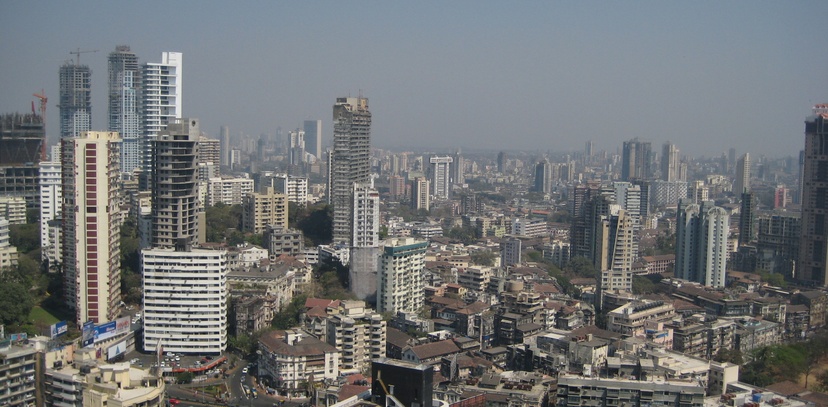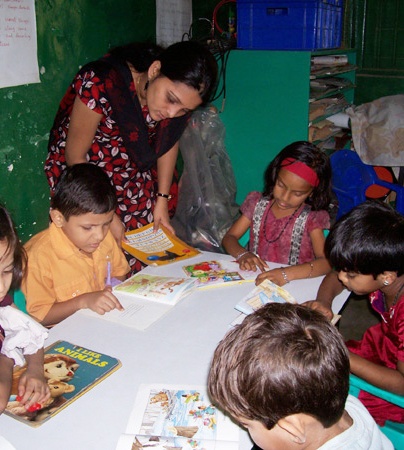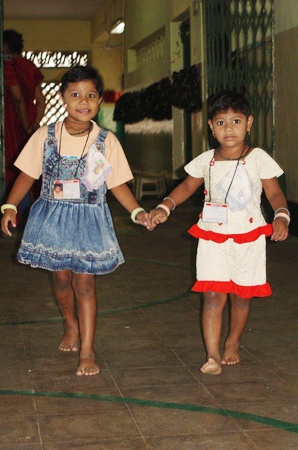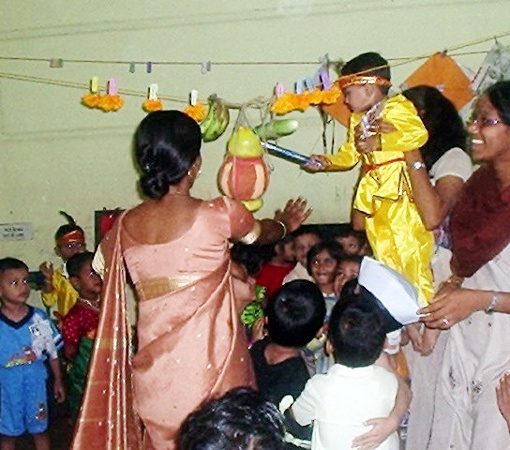
This article is written by Maryanna Abdo as part of the Social Life of Cities series.
“I will play with clay.” The words are written carefully in a tiny hand. In another notebook, the most recent entry reads: “Today I will make a puzzle.” These are personal plans, written by eight- and nine-year old children at the start of the school day. On the day I visit Muktangan, an innovative educational model serving marginalised children in seven Mumbai schools, I observe a class of 40 students putting these plans into action: writing stories, putting on performances, and even mapping multiplication equations on the floor with chalk and plastic tokens. The children are responsible, self-directed, confident and engaged. Later, they will review and reflect on their creative time, closing the circle of the “Plan-Do-Review” cycle that is at the heart of Muktangan’s way of working. It is also at the heart of what makes this project so unusual, and so promising, especially in Mumbai.
Muktangan’s model, and innovative education programmes like it, could be the beginning of a change in India’s education system, which has so far not kept up with the country’s rapid urbanisation and attending economic growth. I visit the programme to understand what makes the model so special, and so promising for a city like Mumbai with such high potential, and such significant problems.
To get to Globe Mill Passage School, I cross the city in one of the 100,000 cabs that choke its streets. The sound of honking is intense, as is the sun shining through the window. There are people everywhere: in cabs, in buses, sleeping on the sidewalk, zooming by on scooters.
It’s difficult to get a firm estimate of the population of Mumbai, but most believe it is about 20 million. This is not just a mega-city, it is the “Maximum City” – an apt moniker for this metropolis so rich in hyperbole. The richest city in South, West or Central Asia with per-capita GDP of three times the national average. The home of glitzy, larger-than-life Bollywood. A city of many ‘slumdogs’ (about 60% of its population lives in slums), and no small number of millionaires, exemplified by Bollygarch Mukesh Ambani, with his $1bn, 27-storey personal home.
With annual population growth of roughly 3%, most of it due to migration, Mumbai is typical of India’s rapid urbanisation. The 2011 census indicated that 30% of India is urban, but many believe the figure is closer to 50%. As a country urbanises, national productivity and prosperity typically increase, and cities could produce more than 70% of GDP across India.1 The country is also in a lucky period known as “demographic dividend,” a transitional phase of economic growth in which dependency on public welfare declines and productivity of the young working population increases.
This should all be good news, but government policy hasn’t caught up to these important realities. Many programmes are focused on rural development, but far fewer address urban poverty. “Policy-makers’view of India is that it is hot, dusty and rural,” Mumbai journalist Aparna Piramal Raje tells me. “Yes, it’s hot and dusty,” she says, “but it’s an urban shantytown somewhere.”
This lack of effective urban policy is perhaps most noteworthy, and most troubling, in education. India is not producing enough qualified graduates to drive skilled jobs in its cities. In the OECD’s 2009 PISA tests, which assess reading, maths and science, India ranked 72nd of 73 participating countries. Despite high rates of enrolment, learning in India is often disempowering and by rote, with highly competitive exams favoring wealthy children whose families can afford tutoring. The teacher’s role is often simply to police a too-large classroom, which brews frustration and apathy. This, among other factors, drives teacher absenteeism of 25% or more.2 Moreover, higher education isn’t growing fast enough to deliver economic growth; The Parthenon Group found that at current rates of capacity growth India will have more college-uneducated adults in 2020 than it does today.3 But perhaps most worryingly, children graduate without having learned the non-cognitive skills – collaboration, creative problem solving, resilience – that are so integral to life chances.4 If trends continue, Parthenon warns, India could see its valuable “demographic dividend” turn into a “demographic deficit”. 5
Seasoned educator Elizabeth Mehta, founder of Muktangan, saw the need for change: “I had learnt that education for the majority was didactic and teacher-centred, with the child not taken into account”. Mehta, a UK native who moved to India more than 40 years ago, founded the first Muktangan school in 2003 with seven teachers teaching just 90 students. They set out to create a different kind of school, one that was sustainable, inclusive of children with disabilities, child-centred, and English-medium, offering quality education to children in poor communities – those most likely to be left behind in India’s rapid urban growth. Muktangan means “open courtyard” emphasising the free, safe space the programme creates for children. The schools are municipal schools, occupying a floor of a typical school building but running as an alternative track.
Muktangan schools follow the government syllabus, but they function as distinct operational and pedagogical entities. The programme is an experiment, a whole-school solution intended to prove that a high-quality, English-medium education is replicable, sustainable and scalable within government constraints and for the wider sector.
While initially envisioned as a pre-school, Muktangan was so popular among parents that they asked it to add more grade levels. “They said,” Mehta recounts, “the children are so confident. They cry on the weekend because they are not going to school”. Later, the government asked it to expand to an additional six schools. Muktangan now reaches 2,400 children across seven schools. UNICEF has decided to spread the model further, training 10,000 teachers across the state of Maharashtra in the Muktangan method.
The “Muktangan method” is constructivist, a pedagogical style that contextualises learning in a child’s own experience and discovery, moving from the immediate and concrete to the abstract and theoretical. There is a strong focus on nurturing a child’s agency and latent talents – for example in the Plan-Do-Review activities, which allow children to direct their own time. Teachers are trained in how to adjust to each child’s preferred pace and learning style. Rehka Ananda Tadake, a Muktangan faculty member, emphasised the method’s benefits: “It helps them develop their creativity, thinking power, their interest. The teachers recognise and nurture their special talents. Then they can plan for their future. They can hope”.
All Muktangan teachers are from low-income communities and are trained to become classroom teachers. They now number over 350 individuals and most are women. The teachers hail from the same neighbourhoods as the pupils they teach, in contrast to most teachers in municipal schools, which means they share the same community context as the children. Their learning is also constructivist, focused on empowering them as facilitators in the classroom. As a sign of how vital teacher training is to the programme, more than 80% of Muktangan’s budget is spent on teacher education and faculty for both pre- and in-service training. Teachers’ status often goes up in the community and they become more empowered in other areas of their lives. “I have grown so much with Muktangan” one said.
Muktangan also innovates in operations and design. In Muktangan classrooms, pupil-teacher ratio drops from the Mumbai average of 45-1 to just 12-1, with three teachers managing a single classroom of students split into groups. Each group has its own blackboard, cluster of desks, and resources. The furniture is light and portable, so the room can be cleared quickly for activities and play. The walls are colorfully painted and decorated with features that allow the children to “imbibe and absorb” key lessons, as Sasha Chettri, Muktangan Resources team member, tells me. For example, in a 3rd standard classroom I visit, cards reading “North, South, East, West” are taped to the relevant walls. Also, because space is at a premium, Chettri points out that the school finds ways to use it creatively: satchels line up in neat rows on a shelf outside the classroom; the floor doubles as a chalkboard.
Muktangan’s objective remains to continue to prove that this sort of holistic, high-quality, English-medium education is viable for all of Mumbai’s schools. When I ask what’s next for the programme in that journey, Mehta tells me that Muktangan is considering adopting another cluster of schools, this time in a rural area. Next year’s SSCs - 10th standard exams for Muktangan’s first class of graduating students - will prove to be an important measure of its effectiveness. The staff are quietly confident, and Mehta notes that recent test results for the Marathi language were “astounding”. But Michael Cutts, who is part of the Programme Faculty, underlines a more important outcome: “Academically, we expect they’ll do well. But socially and emotionally, they have already done well. Success for us is a child who has developed holistically and is resilient, as well as being a collaborative and creative critical thinker”.
If any type of education outcome can drive positive change and economic growth in India’s fast-growing, rapidly changing cities, it could be this one.
1 McKinsey Global Institute, India’s urban awakening: Building inclusive cities, sustaining economic growth, 2010
2 World Bank, Missing in Action, 2006
3 The Parthenon Group, Private Universities in India – an Investment in National Development, 2012
4 Paul Tough, How Children Succeed, 2012
5 Karan Khemka, Demographic Dividend or Deficit?, The Times of India, 20 June 2011
Maryanna Abdo
Maryanna Abdo lives in Mumbai and is Director of Business Development for The Parthenon Group, a strategic advisory firm who are the largest advisors to the education sector globally. Mary is a Fellow and former staff member of the Young Foundation, a centre for social innovation in London.


